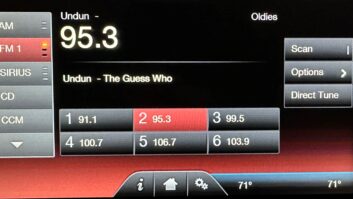(click thumbnail)Fig. 1: Keep a spare blower motor on hand for that inevitable failure.
(click thumbnail)Fig. 2: Don’t launch a missile. Keep nitrogen tanks secured.
(click thumbnail)Fig. 3: Mark the location of AM coil clips with a permanent marker. Yes, antennas and line sometimes will leak air. But if you’re losing tanks of air on your pressurized FM lines, more than likely you will find the problem on the ground.
Armed with a fresh tank of air, pressurize the line to about 3 psi, as read on your regulator. Then spritz a bottle of Formula 409 or similar brand cleaner on the manifold, fittings and regulator assembly and along the hose connecting them. A multitude of little bubbles will point to your leak if it’s on the ground.
You may be able to fix it, using a procedure contributed by Paul Sagi of Kuala Lumpur.
Paul recently traced a slow leak to a valve. It turned out the leak was a slow seepage around the valve stem, caused by the packing not sealing properly. Since he didn’t have any graphited asbestos valve packing, and would not want to use it anyway, perhaps being overly cautious because of the asbestos, he took a length of Teflon pipe thread sealing tape.
Paul rolled the tape to make a thread, then doubled it and rolled it again. His goal was to obtain the length and thickness needed for the cavity under the packing nut. The fix works fine, and since the valve is not turned very often, it’s lasted a reasonable time.
* * *
B. J. Crabb from WFTA(FM) in Tupelo, Miss., wrote about the exhaust fan shown in the June 21 Workbench. Where do you find one?
A good place to start is the Grainger catalog. If you don’t have it handy, go online to www.grainger.com and select “HVAC>fans” – you’ll find 37 different fan categories. The site has a PDF catalog that you can download, but stock a ream of paper if you’re going to print it out. You’re better off contacting them for your own copy.
Grainger also has in stock the big blower motors used in high-power transmitters, as shown in Fig. 1. Even if you don’t have the budget for a spare, note the model number and cost. This info can be a lifesaver should you lose your transmitter blower.
* * *
If your nitrogen tanks aren’t secured as seen in Fig. 2, you’re playing with fire – or missiles.
A fire marshal once told me about a tank that fell to the floor, breaking off the regulator; the pressurized tank turned into a projectile, blasting through two cinder block walls and ending up in a field outside the transmitter building.
Don’t take a chance. Keep caps on unused tanks, and secure those in use. Thanks to Paul Shulins at Greater Media Boston for sharing the tank securing methods.
* * *
Have you poked around your AM coupling network or phasor lately? With the parameters all within tolerance, now’s a good time to mark the location of all coil taps.
As seen in Fig. 3, a Sharpie brand indelible marker is used to mark either side of the clip. This must be done when you’re off the air. The result, however, is insurance should a coil clip drop off or burn. You’ll save hours of time resetting the coil to the marked location. Thanks to Grady Moates at Loud and Clean for sharing this useful tip.
If you like stories about building stations from the ground up, visit www.loudandclean.com for a reprint of an RW article by Grady about building an FM in Bermuda. It’s great reading.















